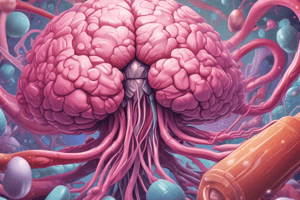Podcast
Questions and Answers
What is the primary source of estrogen in postmenopausal women?
What is the primary source of estrogen in postmenopausal women?
- Pituitary gland
- Peripheral aromatization (correct)
- Adrenal glands
- Ovarian synthesis
What is the effect of aromatase inhibitors on estrogen synthesis in postmenopausal women?
What is the effect of aromatase inhibitors on estrogen synthesis in postmenopausal women?
- Increase estrogen synthesis
- Totally eliminate estrogen synthesis
- Have no effect on estrogen synthesis
- Decrease estrogen synthesis (correct)
What is the mechanism of action of Trastuzumab?
What is the mechanism of action of Trastuzumab?
- It inhibits the expression of HER2 protein
- It binds to HER2 sites and promotes cell proliferation
- It stimulates the production of HER2 protein
- It binds to HER2 sites and inhibits cell proliferation (correct)
What percentage of patients with metastatic breast cancer overexpress the HER2 protein?
What percentage of patients with metastatic breast cancer overexpress the HER2 protein?
What is the advantage of targeted therapy in cancer treatment?
What is the advantage of targeted therapy in cancer treatment?
What is the function of Anastrozole?
What is the function of Anastrozole?
Where does peripheral aromatization take place?
Where does peripheral aromatization take place?
What is the effect of Trastuzumab on cell proliferation?
What is the effect of Trastuzumab on cell proliferation?
What is the advantage of using targeted therapy in combination with traditional chemotherapy?
What is the advantage of using targeted therapy in combination with traditional chemotherapy?
What is the target of Trastuzumab in breast cancer cells?
What is the target of Trastuzumab in breast cancer cells?
Study Notes
Anticancer Agents
- Antimetabolites are structurally related to normal compounds that exist within the cell and interfere with the availability of normal purine or pyrimidine nucleotide precursors.
Methotrexate
- Mechanism: inhibits mammalian dihydrofolate reductase (DHFR), the enzyme that converts folic acid to its active, coenzyme form, tetrahydrofolic acid
- Therapeutic uses: effective against acute lymphocytic leukemia, breast cancer, bladder cancer, and head and neck carcinomas, as well as inflammatory diseases such as severe psoriasis, rheumatoid arthritis, and Crohn disease
- Adverse effects: depression, nausea, vomiting, bone marrow suppression
Cyclophosphamide
- Mechanism: alkylating agents that covalently bind to nucleophilic groups on various cell constituents, leading to DNA alkylation and cytotoxicity
- Therapeutic uses: useful in many solid tumors due to its prominent immunosuppressant property
- Adverse effects: alopecia, cystitis (due to acrolein)
Doxorubicin
- Mechanism: disrupts DNA function, inhibits topoisomerases (I and II), and produces free radicals
- Adverse effects: irreversible, dose-dependent cardiotoxicity
Vincristine
- Mechanism: binds to microtubular protein-tubulin, prevents its polymerization and assembly of microtubules, causing disruption of mitotic spindle and interference with cytoskeletal function
- Therapeutic uses: induces remission in childhood acute lymphoblastic leukemia
- Adverse effects: peripheral neuropathy, alopecia
Prednisone
- Mechanism: potent, synthetic, anti-inflammatory corticosteroid
- Therapeutic uses: induces remission in acute lymphocytic leukemia, and treats both Hodgkin and non-Hodgkin lymphomas
Tamoxifen
- Mechanism: estrogen antagonist with some estrogenic activity, classified as a selective estrogen receptor modulator (SERM)
- Therapeutic uses: first-line therapy for estrogen receptor-positive (ER+ve) breast cancer, and prophylactically reduces breast cancer occurrence in high-risk women
Anastrozole
- Mechanism: aromatase inhibitor, decreases estrogen production in postmenopausal women
- Therapeutic uses: treats estrogen receptor-positive breast cancer
Targeted Therapy
- Mechanism: targets specific pathways, processes, and proteins uniquely disrupted in cancer cells or the tumor microenvironment
- Advantages: more effective treatments that can attack specific breast cancer cells without harming normal cells, with fewer severe adverse effects
Trastuzumab
- Mechanism: humanized monoclonal antibody, specifically targets the extracellular domain of the HER2 growth receptor
- Therapeutic uses: treats HER2-overexpressing breast cancer and gastric cancer
Studying That Suits You
Use AI to generate personalized quizzes and flashcards to suit your learning preferences.
Description
Learn about different types of anticancer agents, including their mechanisms of action, clinical uses, and adverse effects. This quiz covers Methotrexate, Doxorubicin, Cyclophosphamide, Vincristine, Prednisone, Tamoxifen, and Anastrozole.




